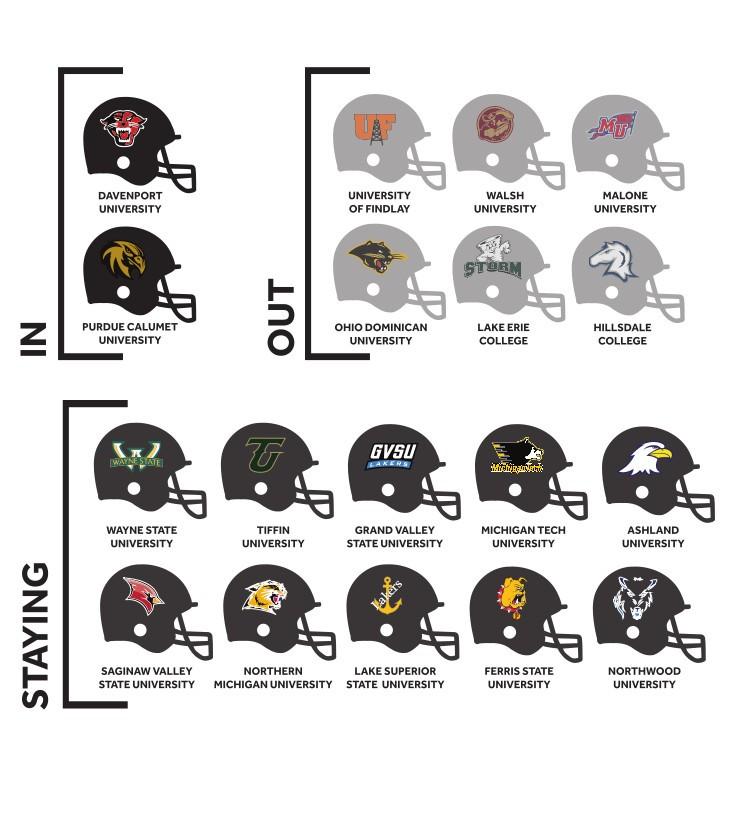GLIAC plans to add Davenport, Purdue Calumet

Jan 21, 2016
The revolving door of college athletics continues to spin in the Great Lakes Intercollegiate Athletic Conference (GLIAC). Drastic changes are coming by the 2017-18 academic year.
Out with Malone at the end of this season, and then Findlay, Hillsdale, Lake Erie, Ohio Dominican and Walsh after the next year, as they all bounce over to the Great Midwest Athletic Conference (G-MAC). The departures leave a formidable void with the GLIAC rapidly declining from 16 to 10 competing schools in just two seasons.
Enter in Davenport University and Purdue University Calumet, which will be renamed to Purdue Northwest over the summer with the unification of its Calumet and North Central campuses.
Both universities recently accepted invitations to join the GLIAC starting in 2017-18, and await the final approval by the NCAA Division II membership program, which should happen by July.
What impact will these changes in the conference have on Grand Valley State athletics? Scheduling, recruiting and new competitors.
“Assuming they get accepted for Division II membership, then for the 2017-18 year we will have 12 schools, and that’s very helpful to our conference in terms of scheduling,” said GVSU Athletic Director Tim Selgo. “There will be 10 football-playing schools, so then you have nine conference games and you have to get two non-conference games. It’s very difficult to get non-conference games in Division II anymore because most of the conferences are 12-16 members big, and they don’t have many opportunities anymore for cross-conference competition.
“That’s true in all sports because we will have fewer conference members, so we will have more work to do in non-conference schedule.”
Simply put, the more teams that are in the conference, the easier scheduling becomes.
The Peregrines of Purdue Calumet currently sponsor 13 National Association of Intercollegiate Athletics varsity sports. They will be the first full-time GLIAC member from Indiana, being located just outside of metro Chicago in Hammond.
New conference recognition outside of Michigan provides more recruiting opportunities. Plus, there will be less competition with five of the departing schools being located in Ohio.
“I think (conference changes) will help us in recruiting, specifically in Ohio,” said GVSU head coach Matt Mitchell. “I think most kids want to play at the highest level they can and I believe the GLIAC will maintain a good image.”
Davenport, located in Grand Rapids, Michigan, offers 20 NAIA programs. The Panthers are no strangers to success, having won five consecutive Wolverine-Hoosier Athletic Conference All-Sports trophies since 2011.
According to Selgo, new schools coming into a league traditionally need time before the athletic programs become competitive. The quality of competition that these two schools bring to GLIAC should be evaluated on a sport-by-sport basis, and given some leeway.
“In some sports, those schools probably have teams that are competitive immediately,” Selgo said. “Now, whether they are competitive enough to win the GLIAC remains to be seen. Then they have other sports that will take some time.”
For example, Davenport’s football team will take the field for the first time this fall. Understandably, it might take them a while to get up to speed with the high quality of competition in the GLIAC. But, Mitchell isn’t going to take any opponent lightly – old or new.
“To be determined,” Mitchell said to the suggestion that Davenport could drag down the conference competitively in football. “I have never seen (Davenport) on tape. I have never seen them play. I don’t know. Until we line up or I see them on tape, it’s hard for me to comment on that.”
Geographically separated by less than 28 miles, the elephant in the room has to be the budding possibility of a new rivalry emerging between GVSU and Davenport.
While Mitchell consistently deflects questions about rivalries and maintains the prominent coaching mantra of focusing on “one game at a time,” Selgo provided an intriguing comparison to a Division I cross-town rivalry.
“A similar rivalry to the potential of Grand Valley and Davenport is North Carolina and Duke. You have a public school, North Carolina, with about 30,000 students and Duke is private school with about 7,000 students.”
The intensity of a Tar Heels versus Blue Devils showdown won’t happen overnight. But, over time, the Lakers and Panthers seemingly have the ingredients needed to create another marquee matchup that envies the Anchor-Bone Classic or the Battle of the Valleys.






















